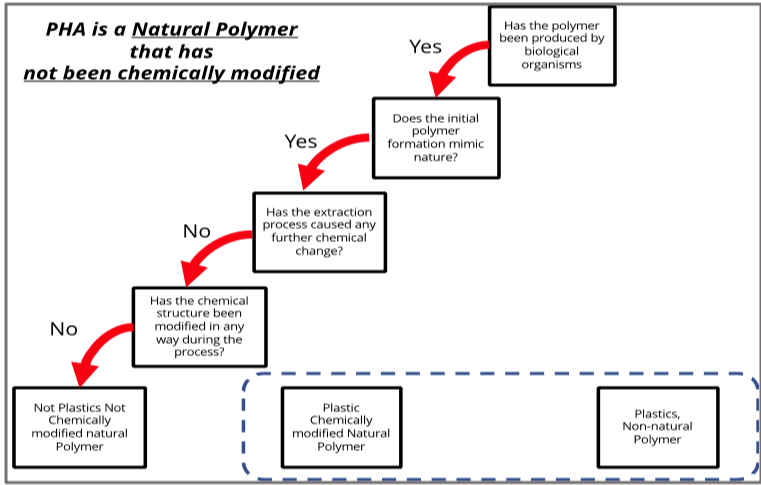The SUP Directive 1 (P8-TA-2019_305) mentions in Article 3 (1) the definition of “plastic”, “natural polymer” and “chemically modified polymer”, in order to identify materials that would be subject to exclusions from the above-mentioned SUP Directive.
PHA is a Natural Polymer, which is not chemically modified. Additionally, they have excellent end of life biodegradability in all environments including marine environments and is produced from renewable substrates fit with the European Commission’s own vision of a Circular Economy.
GO!PHA, an Industry Organization, representing the PHA Industry and its downstream market participants, requests the European Commission (hereafter Commission) to clarify that PHA produced via the cultivation of microorganisms, and having identical structures and chemical compositions as naturally occurring PHA, are classified as Natural Polymers within the scope of the SUP Directive.
Hereby we respectfully submit our comments and arguments in favour of our request for the EU to classify PHA as Natural Polymers.
The origin of the definitions of “Plastics”, “Polymers”, “Natural Polymers” and “Chemically Modified Polymers” are the ECHA guidelines of 2006 2 and their subsequent revisions.
The ECHA guideline states:
“Natural polymers are understood as polymers which are the result of a polymerization process that has taken place in nature, independently of the extraction process with which they have been extracted. This means that natural polymers are not necessarily ‘substances which occur in nature’ when assessed according to the criteria set out in Article 3(39) of the REACH Regulation.
Following Article 2(9) of REACH, any polymer meeting the criteria of Article 3(5), whether natural polymers or not, does not have to be registered. This exemption from registration includes natural polymers which are chemically modified (e.g. post- treatment of natural polymers).”
The second sentence in the first paragraph in the above-mentioned quote on Natural Polymers outlines that Natural Polymers do not need to occur in nature on their own and clearly seen differently than substances which occur in nature as it is independent of the extraction process. Therefore, polymers can be called “natural” when made in a different setting, such as fermentation, which is a natural process that uses microorganisms except it is controlled in an industrial setting and produces polymers that are chemically and structurally identical to those found in a natural setting.
The definition of a Natural Polymer should also be seen via the definition of a “Natural Substance” as elaborated by ECHA Guidance for Exemptions from the obligation to register, Annex V, Version 1.1, November 2012 (pages 18-19)3 which is defined as:
“Naturally occurring substances as such” means, substances obtained, for example, from plants, micro-organisms, animals, or certain inorganic matter such as minerals, ores and ore concentrates, or organic matter such as crude oil, coal, natural gas”.
The definition above and other parts there-of states that microorganisms are biological entities, same as plants or animals. Therefore, substances obtained by cultivating them via fermentation must be considered Natural Substances, similar to materials obtained from plants and animals that are harvested/cultivated/raised to obtain substances which are also considered Natural Materials.
Based on ECHA guidelines covering Natural Polymers and Natural Substances outlined above PHA is a Natural Polymer, is not chemically modified and a Natural Substance.
This is further illustrated using the methodology used in the January 21st Eunomia report “What is Plastic” 4:

In addition, the Eunomia Report states the following with regard to PHA presented by Nova Institut5 and 17 renowned experts in the field of plastics, molecular biology and microbiology:
“In an open letter to DG Environment, issued in September 2019, the Nova Institut 5 identified several other substances which they believe are “natural polymers” and should be exempt from the provisions of the SUP Directive. One notable polymer on this list was Polyhyroxyalkanoates (PHA), classed under “natural Polymers produced via biosynthesis in bacteria”. The polymer is produced by bacteria (biological organisms), but the commercial production of the polymer does not take place in nature. As such, based on the ECHA guidance, it directly contradicts one of the conditions of being considered a natural polymer (‘Did the initial polymer formation reaction occur in nature?’), and thus it appears that it could not be considered exempt from the SUP Directive. In addition, the production of PHA depends upon the nutrients added to the culture, reinforcing that the polymer is not being produced “in nature”.”
Referring to multiple ECHA guidelines, the following important arguments against the Eunomia report’s conclusion and recommendation arise:
- Natural Substances made via microorganisms are considered natural as long as their structure and chemical composition mimics the same materials found in nature.
- The definition of Natural Polymers is derived from that of Natural Substances; therefore, Natural Polymers do not need to exist on its own in nature and could be made in another setting as long as it mimics nature in structure and chemical composition.
- Eunomia, in their decision tree to determine if a polymer is a plastic, asked, “Did the initial polymerization reaction occur in nature?” while the entire definition of Natural Polymer and Natural Substance does not stipulate the process of its manufacture, rather only whether their structure and chemical composition are identical to those found in nature. That requires the following question be asked; “Does the initial polymer formation mimic nature?”. In the case of PHA the polymer formation occurs inside the microorganism, therefore, the answer to this question is in the affirmative.
- Eunomia mentions that the use of nutrients in an industrial process make PHA unnatural. Microorganisms also use nutrients in nature to make PHA, hence the use of nutrients in fermentation using microorganisms is identical to the natural process.
Based on multiple ECHA guidelines and the definitions for Natural Substances and Natural Polymers, there is sufficient evidence to indicate that PHA are Natural Polymers and that Eunomia’s conclusions are not based on all relevant ECHA guidelines.
In addition, the Eunomia Report mentions that a decrease in molecular weight is a form of chemical modification. This claim is scientifically incorrect. Reduction in molecular weight of polymers in general and in the example given in their report4 (Figure 4: Viscose Production) decrease the physical properties of such polymers and have no
impact on their, chemical composition, therefore reduction in molecular weight of a natural material does not make them unnatural. Furthermore, molecular weight reduction does not change recyclability, biodegradability or compostability, which are all important requirements for any litter that has been left in the environment.
In China6 and in the United States, legislators are also working on regulations to ban Single Use Plastics. The main purpose of these bans, like in the EU, are to curb plastic waste and littering, to avoid their harmful effects to the environment even if such products are left in the environment, and to encourage designing products for circularity.
Exempting only Natural Polymers or Natural Substances alone is not sufficient and wood, a Natural Substance which contains cellulose and lignin is a good example. In marine environments the cellulose will fully biodegrade, but the lignin will not, since lignin needs fungi to make it biodegrade, while fungi are not present in a marine environment.
These definitions were introduced as part of REACH registration in 2006 to ensure proper risk assessments of various man-made chemicals and polymers. These definitions were not created to control litter or to protect the environment from pollution, the primary objectives of the SUP Directive. Therefore, we strongly believe that the utilization of these definitions alone in the SUP Directive leaves room for subjectivity and halts the innovation of promising new materials.
The SUP Directive states that it should act “to prevent and reduce the impact of certain plastic products on the environment, in particular the aquatic environment, and on human health, as well as to promote the transition to a circular economy with innovative and sustainable business models, products and materials, thus also contributing to the efficient functioning of the internal market.” The subjectivity of the definitions mentioned above do not propagate the intent and the spirit of the SUP Directive.
Four key elements defining materials for use in an effective SUP Directive in our opinion are:
- Should not be harmful to the environment in any way when they are purposely or accidentally left in the environment. Therefore, they should:
- Biodegrade into carbon dioxide and water when left in the environment.6
- Be non-toxic and harmless if ingested by birds, animals, fish or marine mammals.
- Should fit into current and future waste collection, recycling and incineration streams, such as be home and industrially compostable, recyclable when large streams of such materials become commercially available, or can be incinerated, if necessary.
- Encourage the use of renewable raw materials that are readily available in the atmosphere (like CO2 or CH4), in the biosphere (renewable substrates) or in the Technosphere (recycled carbon), it also would benefit the environment through reduction of greenhouse gases.
- Establish a regulatory and standards driven regime for biodegradability and compostability rooted in science to allow for the introduction of new and innovative materials.
Based on 40+ years of science and technology-based evidence, PHA is one such innovative Natural Polymer that has not been chemically modified with end of life properties that only nature can design – biodegrade in all natural environments, soil, fresh water and marine environment. We thank the Commission for giving GO!PHA’s position due consideration and classifying PHA as Natural Polymers in the final SUP Directive. We are ready to meet and assist the Commission with further discussion, evidence and information in order to reach the goals of the SUP Directive.
References
- EU SUP Directive P8-TA-2019_305
- ECHA Guidance for monomers and polymers, April 2012 Version 2, page 20
- ECHA Guidance for Annex V, Exemptions from the obligation to register, Version 1.1, November 2012 (pages 18-19)
- Eunomia Report of January 21, 2020 “What is Plastic”
- Nova Institute, Open Letter to DG Environment, “Which polymers are “natural polymers” in the sense of the SUP Directive, Nova Institut, Hürth, Germany
- Opinions of the Chinese National Development and Reform Commission and the Ministry of Ecology – Nova Institut, Hürth, Germany (included)
- Biodegradable materials in various environments, Nova Institut, Hürth, Germany (included)
Source
GO!PHA, press release, 2020-03.
Supplier
European Commission
European Union
GO!PHA
Share
Renewable Carbon News – Daily Newsletter
Subscribe to our daily email newsletter – the world's leading newsletter on renewable materials and chemicals










